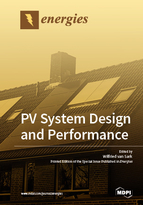PV System Design and Performance
A special issue of Energies (ISSN 1996-1073).
Deadline for manuscript submissions: closed (31 March 2018) | Viewed by 125036
Special Issue Editor
Interests: integration of PV in society in particular in buildings (BIPV) and the (local) electricity grid; simulation and performance analysis of PV systems and modules, shading analyses and shad-resilience options, for land-based and water-based PV systems; forecasting of PV power with AI approaches and sky-imagers; market and footprint analysis of PV systems and circularity approaches
Special Issues, Collections and Topics in MDPI journals
Special Issue Information
Dear colleagues,
Photovoltaic (PV) solar technology has been rapidly and continuously growing in the past decades leading to ~300 GWp installed capacity globally, and this has led to enormous price reductions. The strength of the technology is its modular design, and PV power plants range from a few PV modules (~1 kWp) to millions (~250 MWp). Design of such systems depends on the scale level: residential systems are typically roof-based, either flat or tilted, while large systems allow to design for maximum annual yield but also require intricate electrical layouts with multiple inverters and connections to medium voltage transmission networks. Additionally, operation is scale dependent. In residential areas, non-ideal tilts and potential shading will lower annual yields, and designs to minimize these losses have been developed, using, e.g., power optimization per module. Monitoring of such small systems is rare, as economic loss due to malfunction is low. Large-scale systems have proper supervisory control and data acquisition (SCADA) systems to ensure maximum economic benefit, which is of importance to investors.
This Special Issue solicits papers with original research and studies related to the above-mentioned topics, including, but not limited to, PV system design on residential and larger scales; methods for operational control and analysis; failure detection; performance analysis of systems; mapping performance differences; performance variability; degradation of systems and modules. Papers selected for this Special Issue are subject to a rigorous peer review procedure with the aim of rapid and wide dissemination of research results, developments and applications.
Dr. Wilfried van Sark
Guest Editor
Manuscript Submission Information
Manuscripts should be submitted online at www.mdpi.com by registering and logging in to this website. Once you are registered, click here to go to the submission form. Manuscripts can be submitted until the deadline. All submissions that pass pre-check are peer-reviewed. Accepted papers will be published continuously in the journal (as soon as accepted) and will be listed together on the special issue website. Research articles, review articles as well as short communications are invited. For planned papers, a title and short abstract (about 100 words) can be sent to the Editorial Office for announcement on this website.
Submitted manuscripts should not have been published previously, nor be under consideration for publication elsewhere (except conference proceedings papers). All manuscripts are thoroughly refereed through a single-blind peer-review process. A guide for authors and other relevant information for submission of manuscripts is available on the Instructions for Authors page. Energies is an international peer-reviewed open access semimonthly journal published by MDPI.
Please visit the Instructions for Authors page before submitting a manuscript. The Article Processing Charge (APC) for publication in this open access journal is 2600 CHF (Swiss Francs). Submitted papers should be well formatted and use good English. Authors may use MDPI's English editing service prior to publication or during author revisions.
Keywords
- photovoltaic system design (residential and large scale)
- monitoring of PV systems
- performance analysis
- mapping performance
- performance variability
- shade-resilient system design and operation
- system malfunction detection






